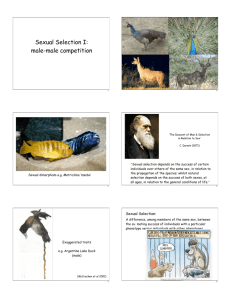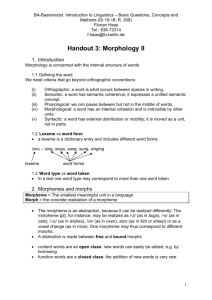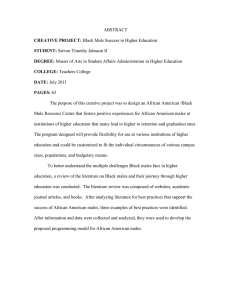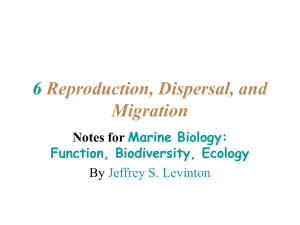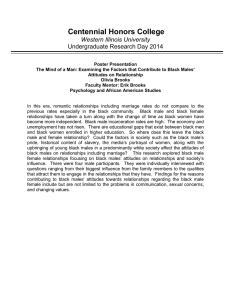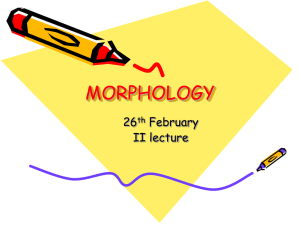Alternative mating strategies may favour the persistence of a genetically
advertisement
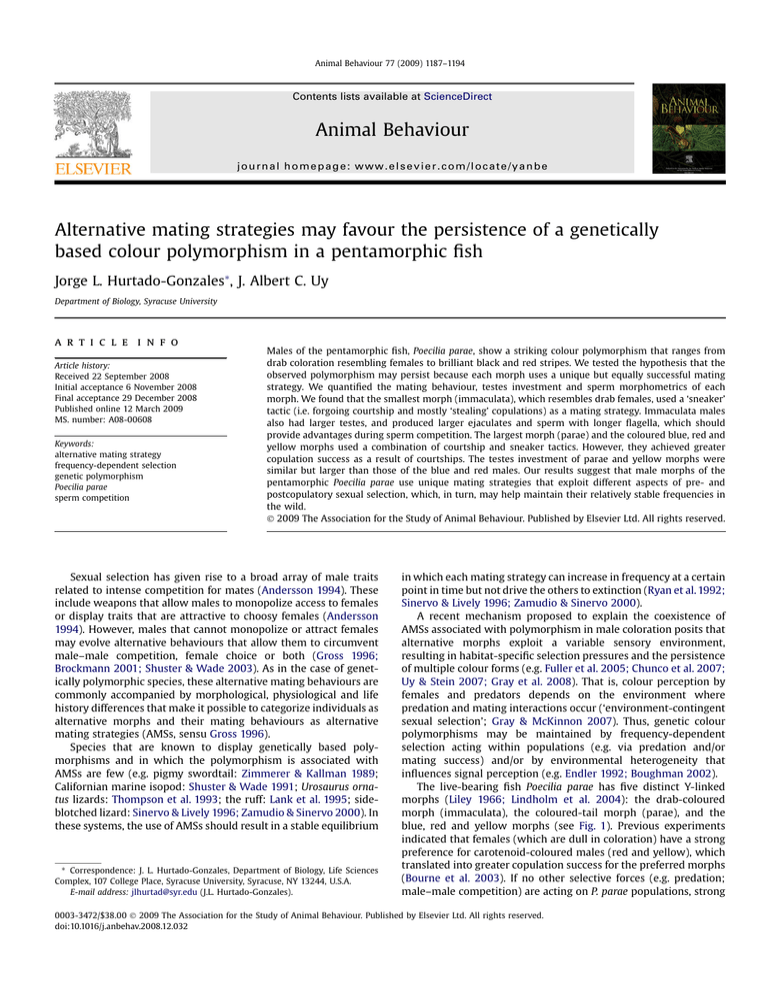
Animal Behaviour 77 (2009) 1187–1194 Contents lists available at ScienceDirect Animal Behaviour journal homepage: www.elsevier.com/locate/yanbe Alternative mating strategies may favour the persistence of a genetically based colour polymorphism in a pentamorphic fish Jorge L. Hurtado-Gonzales*, J. Albert C. Uy Department of Biology, Syracuse University a r t i c l e i n f o Article history: Received 22 September 2008 Initial acceptance 6 November 2008 Final acceptance 29 December 2008 Published online 12 March 2009 MS. number: A08-00608 Keywords: alternative mating strategy frequency-dependent selection genetic polymorphism Poecilia parae sperm competition Males of the pentamorphic fish, Poecilia parae, show a striking colour polymorphism that ranges from drab coloration resembling females to brilliant black and red stripes. We tested the hypothesis that the observed polymorphism may persist because each morph uses a unique but equally successful mating strategy. We quantified the mating behaviour, testes investment and sperm morphometrics of each morph. We found that the smallest morph (immaculata), which resembles drab females, used a ‘sneaker’ tactic (i.e. forgoing courtship and mostly ‘stealing’ copulations) as a mating strategy. Immaculata males also had larger testes, and produced larger ejaculates and sperm with longer flagella, which should provide advantages during sperm competition. The largest morph (parae) and the coloured blue, red and yellow morphs used a combination of courtship and sneaker tactics. However, they achieved greater copulation success as a result of courtships. The testes investment of parae and yellow morphs were similar but larger than those of the blue and red males. Our results suggest that male morphs of the pentamorphic Poecilia parae use unique mating strategies that exploit different aspects of pre- and postcopulatory sexual selection, which, in turn, may help maintain their relatively stable frequencies in the wild. Ó 2009 The Association for the Study of Animal Behaviour. Published by Elsevier Ltd. All rights reserved. Sexual selection has given rise to a broad array of male traits related to intense competition for mates (Andersson 1994). These include weapons that allow males to monopolize access to females or display traits that are attractive to choosy females (Andersson 1994). However, males that cannot monopolize or attract females may evolve alternative behaviours that allow them to circumvent male–male competition, female choice or both (Gross 1996; Brockmann 2001; Shuster & Wade 2003). As in the case of genetically polymorphic species, these alternative mating behaviours are commonly accompanied by morphological, physiological and life history differences that make it possible to categorize individuals as alternative morphs and their mating behaviours as alternative mating strategies (AMSs, sensu Gross 1996). Species that are known to display genetically based polymorphisms and in which the polymorphism is associated with AMSs are few (e.g. pigmy swordtail: Zimmerer & Kallman 1989; Californian marine isopod: Shuster & Wade 1991; Urosaurus ornatus lizards: Thompson et al. 1993; the ruff: Lank et al. 1995; sideblotched lizard: Sinervo & Lively 1996; Zamudio & Sinervo 2000). In these systems, the use of AMSs should result in a stable equilibrium * Correspondence: J. L. Hurtado-Gonzales, Department of Biology, Life Sciences Complex, 107 College Place, Syracuse University, Syracuse, NY 13244, U.S.A. E-mail address: jlhurtad@syr.edu (J.L. Hurtado-Gonzales). in which each mating strategy can increase in frequency at a certain point in time but not drive the others to extinction (Ryan et al. 1992; Sinervo & Lively 1996; Zamudio & Sinervo 2000). A recent mechanism proposed to explain the coexistence of AMSs associated with polymorphism in male coloration posits that alternative morphs exploit a variable sensory environment, resulting in habitat-specific selection pressures and the persistence of multiple colour forms (e.g. Fuller et al. 2005; Chunco et al. 2007; Uy & Stein 2007; Gray et al. 2008). That is, colour perception by females and predators depends on the environment where predation and mating interactions occur (‘environment-contingent sexual selection’; Gray & McKinnon 2007). Thus, genetic colour polymorphisms may be maintained by frequency-dependent selection acting within populations (e.g. via predation and/or mating success) and/or by environmental heterogeneity that influences signal perception (e.g. Endler 1992; Boughman 2002). The live-bearing fish Poecilia parae has five distinct Y-linked morphs (Liley 1966; Lindholm et al. 2004): the drab-coloured morph (immaculata), the coloured-tail morph (parae), and the blue, red and yellow morphs (see Fig. 1). Previous experiments indicated that females (which are dull in coloration) have a strong preference for carotenoid-coloured males (red and yellow), which translated into greater copulation success for the preferred morphs (Bourne et al. 2003). If no other selective forces (e.g. predation; male–male competition) are acting on P. parae populations, strong 0003-3472/$38.00 Ó 2009 The Association for the Study of Animal Behaviour. Published by Elsevier Ltd. All rights reserved. doi:10.1016/j.anbehav.2008.12.032 1188 J.L. Hurtado-Gonzales, J.A.C. Uy / Animal Behaviour 77 (2009) 1187–1194 morphs may invest in courtships to advertise their body colour and size to females, respectively. Finally, we predicted that the observed differences in mating behaviours would be accompanied by differential investment in sperm production and sperm morphometry, favouring morphs that have a mating disadvantage or that specialize in sneak copulations. METHODS Experimental Fish Figure 1. Female and the five male morphs of P. parae. female preferences for carotenoid-based morphs should result in the fixation of red and yellow phenotypes in their natural habitat. However, long-term field surveys indicated that the less preferred morphs are actually more abundant (immaculata: 44%; parae: 42%; blue: 9%; yellow: 4%; red: 1%), and that the frequencies of the five alternative male morphs are constant across years (i.e. 5 years of survey; see Lindholm et al. 2004; J. L. Hurtado-Gonzales & J. A. C. Uy, unpublished data). As a first step to elucidate a possible explanation for the observed high frequency of the less preferred morphs and the overall persistence of all five morphs, our aim for this study was to determine whether male morphs of the P. parae have evolved alternative mating strategies. Males of P. parae use two well-defined mating tactics: courtship displays and sneak copulations (Liley 1966). During courtships, males change the intensity of their body coloration, and display their body flanks and fins to females during a set of short movements repeated several times in quick succession. These courtship displays result in successful copulations if females are sexually receptive (Liley 1966). Sneak copulations, in contrast, do not involve courtships and do not require female cooperation. To achieve a sneak copulation, a male places himself outside of a female’s range of vision by approaching her from behind. Then, the male places himself directly below the female’s anal region and inserts his gonopodium into the female’s genital pore (Liley 1966). This form of behaviour, commonly found in poeciliids, can circumvent female precopulatory mate choice and reduce competition among males (e.g. Houde 1997). Following courtships and sneak copulations that result in successful sperm transfer, males suddenly jump away from the female, spiraling upwards and performing two or three body jerks (Liley 1966; Houde 1997; Pilastro et al. 2002); hence, successful matings in P. parae can also be easily quantified. Parker (1990) showed that, in theory, males specializing in sneaking behaviour face high rates of sperm competition, whereas dominant or attractive males face less intense sperm competition. As a consequence, males that specialize in sneak copulations (i.e. ‘sneakers’) are predicted to invest in traits or behaviours that increase their competitive ability in sperm competition (e.g. larger testes, larger ejaculate size). This prediction has been widely supported in a variety of taxa (reviewed in Wedell et al. 2002), but it has been rarely explored in genetically based polymorphic species (but see Shuster 1987; Jukema & Piersma 2006). Considering the behavioural mating differences between morphs of P. parae, which are accompanied by high rates of promiscuity, we predicted that the smallest morph, immaculata, which lacks conspicuous coloration and resembles a juvenile female, would specialize in sneak copulations. In contrast, we predicted that the coloured (blue, red and yellow) and parae Wild-caught male and female P. parae (Fig. 1) used in these experiments were collected from clear water ditches (0.3–1.5 m) in Guyana during June–August 2006, March 2007 and May–July 2008 from two populations: west (6 410 N, 58 120 W) and east (6 47.20 N, 58 090 W) of the Demerara River. To quantify male mating behaviours, we used individuals only from the west population. However, to determine testes investment and their respective spermatic correlates, we used individuals from west and east populations. To avoid misidentifying a juvenile of the four coloured morphs as an immaculata male, we used only immaculata males that were at least 19 mm in total length, the minimum size at which the four coloured morphs begin expressing their colours (Liley 1966; J. L. Hurtado-Gonzales & J. A. C. Uy, unpublished data). Live individuals were maintained in our laboratories in Georgetown (Guyana) and Syracuse University (U.S.A.) on a diet of commercial flake food and live brine shrimp (12:12 h light:dark cycle, 28 1 C). Quantifying Male Mating Behaviours We captured adult males and females in source ditches from the west population. All individuals were kept in communal tanks for 3 days following capture to reduce stress. Males were, then sorted and housed by morph type. From the pool of sorted morphs, 15 males from each morph (N ¼ 75) were individually isolated for 5 days to increase male sexual responses and to reduce male–male interaction effects. Pregnant females were isolated individually until their fry emerged. We used postpartum females since females are more sexually receptive following the end of the pregnancy cycle (Liley 1966; Houde 1997). Trials in which males and females were unresponsive after 10 min of observations were excluded from our analyses, and were not used again. In total, we obtained mating behaviour from 60 males (12 immaculata, 12 parae, 12 blue, 13 red and 11 yellow). Dimensions of experimental tanks were 32 22 24 cm (L W H). The tanks were filled with treated tap water (14 cm in depth) and a thin layer of gravel, and illuminated with a full spectrum light (70 cm above the tank). The tanks were covered on three sides with brown, craft paper, with the uncovered side facing a SCL-810 Hi8 Samsung camcorder. Trials were conducted from 0600 to 1200 hours and from 1500 to 1800 hours, which are times when P. parae are most active (J. L. Hurtado-Gonzales, personal observations). Before each trial, a male and a female were placed in the test tank, which had a removable barrier that prevented physical and visual contact. Fish were allowed to acclimate for 10 min. At the start of the experiment, the opaque barrier was lifted, allowing the test female and male to interact. After trials ended, each individual was anaesthetized with MS-222 (3-aminobenzoic acid ethyl ester) and a lateral digital picture of each individual was taken. We measured the total length (tip of the upper jaw to tip of caudal fin) for each individual from the digital images using Sigmascan ProÒv5.0.0 (San Jose, CA, U.S.A.). From the videos, we recorded the number of (1) courtship displays, (2) copulations as a result of courtships, (3) gonopodial thrusts (hereafter sneak copulations) and (4) failed sneak copulations (hereafter sneak J.L. Hurtado-Gonzales, J.A.C. Uy / Animal Behaviour 77 (2009) 1187–1194 attempts). Behaviours performed by each male were quantified, and then standardized by the length of the experiments (i.e. behaviour per 10 min) and converted to proportions. Classes of mating behaviours were based on detailed ethograms of P. parae compiled by Liley (1966). Determining Testes Investment To obtain a natural measure of testes investment, 288 males (west: N ¼ 168; east: N ¼ 120) were caught from local ditches and were immediately euthanized in a water bath containing MS-222. We measured male total length (see Methods above), and removed their gonads. Gonads and soma were dried in a conventional laboratory oven at 80 C for 48 h, and weighed to the nearest 0.001 g (ATI Cahn C-35, Cahn Instruments, Boston, MA, U.S.A.). 1189 analysed GSI with a nonparametric factorial design (Shirley 1987), since the GSI data did not meet the assumptions of parametric tests. For the TAM, we log-transformed testes and soma mass, and constructed a general linear model (GLM; covariate: log soma mass (LSM); fixed factor: morph type and population (west and east); dependent variable: log testes mass (LTM)). The model included full factorial interactions. We analysed sperm morphometry with MANOVA to compare the difference in variance between populations and between morphs, and their respective interactions. All descriptive values are reported in their original units (mm or mg), and expressed as means SE. Significant differences between morphs were also determined using Tukey multiple comparison tests. RESULTS Quantifying and Characterizing Sperm Numbers and Sperm Morphometry Males of each morph (immaculata: N ¼ 10 west, N ¼ 7 east; parae: N ¼ 10 west, N ¼ 10 east; blue: N ¼ 10 west, N ¼ 10 east; red: N ¼ 7 west, N ¼ 6 east; yellow: N ¼ 10 west, N ¼ 5 east) were isolated from communal tanks for 5 days to ensure and standardize sperm replenishment. Males were then stripped for sperm to quantify the number of sperm and size of ejaculate following standard method used in guppies (P. reticulata; Kuckuck & Greven 1997). Likewise, to characterize and compare sperm morphology, we followed methods developed for guppies (Matthews et al. 1997). Briefly, after stripping a male, all recovered sperm packages were initially diluted in 100 ml of physiological solution (NaCl 0.9%) or until we obtained a proper counting concentration needed for a Neubauer chamber haemocytometer (ca. 100). The mean number of sperm produced by each morph was quantified by taking the average of sperm count from five counts, then multiplying it by the sample dilution factor and the initial volume. From the same sample, we placed 7 ml of sperm dilution on a microscope slide, covered it with a cover slip and observed it at 1000 magnification. We obtained digital images of individual sperm with a Dage CCD72 camera mounted on an Olympus BX60 microscope, allowing us to measure the lengths of the head, midpiece, flagellum, and total spermatozoa to the nearest 0.01 mm using NIH freeware (http://rsb.info.nih.gov/nih-image). We measured 20 spermatozoa per male (N ¼ 1700 spermatozoa for 85 males/5 morphs). Statistical Analyses Statistical analyses were performed using SPSS 15.0 for windows (SPSS, Chicago, IL, U.S.A.). All data were tested for normality. Behavioural data were analysed using MANCOVA (covariates: total body length of males and females; fixed factors: morph type (immaculata, parae, blue, red and yellow); dependent variables: number of courtship displays, copulations as a result of courtship displays, sneak copulations and sneak attempts). Proportions were arcsine transformed. When the MANCOVA was significant, we performed univariate tests for each dependent variable. Moreover, to determine differences between morphs, we used Tukey multiple comparison tests. For testes investment among morphs within and between populations, we used two approaches: (1) the gonadosomatic index (GSI ¼ testes mass/body mass), which assumes proportional increase of testes size with sperm demand (de Vlaming et al. 1982; Stockley et al. 1997) and (2) the testes allometry model (TAM), which has been used to quantify testes variation in fish that have conditional mating strategies (Tomkins & Simmons 2002). We Male Mating Behaviours After controlling for individual length (Table 1), we found that the five distinct morphs differed in their mating behaviours (MANCOVA: F16,153.39 ¼ 2.71, P ¼ 0.0008). Male morphs varied in the number of courtships displays initiated (F4,53 ¼ 5.16, P ¼ 0.001). The Tukey test indicated that parae, blue and yellow morphs initiated more courtship displays to females than did the immaculata and red morphs (all P < 0.05; Fig. 2a). A significant difference was also found in the proportions of sneak attempts (F4,53 ¼ 3.41, P ¼ 0.01), where the immaculata males performed significantly more attempt sneak copulations than any other morph, and the blue morphs the least (all P < 0.05; Fig. 2a). Considering all the successful copulations achieved as a result of elaborated courtships between parae, blue, red and yellow morphs, we found no statistical difference (F4,53 ¼ 1.78, P ¼ 0. 15). However, all larger morphs achieved more copulations as a result of elaborate courtships than did immaculata males, which obtained none. Likewise, there was a difference in the proportions of successful sneak copulations (F4,53 ¼ 6.05, P ¼ 0.004), from which immaculata males achieved greater success than the other four morphs (all P < 0.01; Fig. 2b). Intermorph Body Length Differences Within and Between Populations The total body length of male morphs differed within (ANOVA: F4,278 ¼ 25.55, P < 0.001; Fig. 3) and between the east and west populations (ANOVA: F1,278 ¼ 14.55, P < 0.001). Males of the west population were longer in body length. Within populations, immaculata was the shortest morph (P < 0.01), whereas parae was the longest morph (P ¼ 0.004). We found no difference in total body length between blue, red and yellow morphs (all P > 0.05), which were intermediate in body length to the immaculata and parae morphs. Table 1 Total lengths of male morphs (MTL) and females (FTL), and alternative mating behaviours of P. parae Morphs N MTL (mm) FTL (mm) Attempts Sneaks Courtship Immaculata Parae Blue Red Yellow 12 12 12 13 11 20.390.11 26.170.31 22.640.22 23.130.38 24.560.19 29.840.78 35.671.54 36.851.43 30.462.26 32.170.66 5.591.17 5.170.48 2.190.78 2.110.55 3.730.91 0.820.14 0.080.04 0.220.09 0.220.07 0.350.13 0.740.40 4.811.13 5.170.56 1.510.51 4.650.60 All measurements are given as means SE. Mating behaviours are expressed as the number of behaviours/10 min trial period. 1190 J.L. Hurtado-Gonzales, J.A.C. Uy / Animal Behaviour 77 (2009) 1187–1194 Courtships Sneak attempts 0.8 0.6 0.4 0.2 1 (b) Courtships Sneak attempts 0.8 0.6 0.4 0.2 0 Ye llo w d Re e Bl u la ta Im m Ye ac u llo Re w d e Bl u Pa ra e Im m ac u la ta 0 Pa ra e Proportion of mating behaviour (a) Proportion of successful copulations 1 Figure 2. Proportion of (a) elaborate courtships and sneak attempts, and (b) copulations as a result of courtships and sneak attempts. Data are based on individual 10 min trials of observations for the five P. parae colour morphs. Lower case or upper case letters above the bars indicate significant differences between morphs (P < 0.05) as a result of Tukey’s multiple comparisons within each mating behaviour and within each form of mating success. Note that none of the courtships resulted in successful copulations for immaculata males. Testes Investment Testes mass (mg) differed between morphs (ANOVA: F4,283 ¼ 4.19, P < 0.01). Testes of parae and yellow males and of blue and red males were 90% and 70%, respectively, of the immaculata absolute testes mass (Fig. 4). We found no difference in GSI between populations (c21 ¼ 0.6, N ¼ 2, P ¼ 0.44), and no interaction between population and morph type (c24 ¼ 6.47, N ¼ 5, P ¼ 0.17). After pooling the GSI data from both populations, we found that the five male morphs varied in their GSI (Kruskal–Wallis test: H4,288 ¼ 62.27, P < 0.001), with the immaculata morph showing the largest GSI investment (P < 0.001), and blue and red morphs the least (P < 0.001). Population had no effect on LTM (population: F1,268 ¼ 0.15, P ¼ 0.69), and there was no interaction between testes size among morphs and population (population morph type: F4,268 ¼ 1.05, P ¼ 0.38; population LSM: F1,268 ¼ 0.29, P ¼ 0.59; population 26 B 22 c * c * 0.22 c C * C C a A 34 46 51 28 Immaculata Parae 0.24 * 21 20 We found no differences in ejaculate volume (ml) between morphs across populations (population morph type: F4,75 ¼ 0.33, P ¼ 0.86; population total length: F1,75 ¼ 0.05, P ¼ 0.82; population morph types total length: F4,75 ¼ 0.33, P ¼ 0.86). 33 25 16 10 34 11 Blue Red Yellow Mean testes mass (mg) Total length (mm) b 24 23 Ejaculate Volume and Sperm Morphometry West East * 25 morph types LSM: F4,268 ¼ 1.19, P ¼ 0.32). Thus, we combined data from both populations for subsequent analyses. The full model confirmed that there was an effect of LSM and morph type on LTM, but the interactions were not significant (Table 2). The reduced model showed a strong association between morph type and testes investment, which followed a linear relationship with LSM: immaculata (r2 ¼ 0.26, P < 0.001); parae (r2 ¼ 0.11, P ¼ 0.002); blue (r2 ¼ 0.35, P < 0.001); red (r2 ¼ 0.42, P < 0.001); yellow (r2 ¼ 0.23, P ¼ 0.001; Fig. 5). Coincident with the GSI results, the LGM of immaculata males was higher than the other four morphs (P < 0.001). Parae and yellow males had larger testes investment than did blue and red males (P ¼ 0.01). 0.20 0.18 0.16 0.14 0.12 Figure 3. Mean SE body length of males of the pentamorphic P. parae from the west (,) and the east (-) populations. Samples sizes are shown within each bar. Different letters denote significant differences between morphs within and between populations. *P < 0.05. Immaculata Parae Blue Red Yellow Figure 4. Mean SE testes mass of immaculata (N ¼ 80), parae (N ¼ 79), blue (N ¼ 58), red (N ¼ 26) and yellow (N ¼ 45) P. parae males. J.L. Hurtado-Gonzales, J.A.C. Uy / Animal Behaviour 77 (2009) 1187–1194 Table 2 Results from the ANCOVA model (full model and reduced model) of log testes mass on the pentamorphic P. parae using log soma mass as the covariate Source Model Morph type Log soma mass Morph type*log (soma mass) Error Full model Reduced model df Mean SS F P df Mean SS F P 9 4 1 4 0.37 0.02 2.27 0.02 12.07 0.81 75.06 0.73 <0.001 0.52 <0.001 0.58 5 4 1 0.64 0.44 2.46 21.24 14.69 81.77 <0.001 <0.001 <0.001 278 0.03 282 0.03 Significance level was set at 0.01. 1191 F3,73 ¼ 0.62, P ¼ 0.60). After pooling data across populations, we found that morphs did not differ in sperm head length, but differed in midpiece, flagellum and sperm total length (Table 3). Immaculata males had the shortest midpiece (P < 0.03) but the longest flagellum (P < 0.01) compared to the other morphs. Males of the yellow morph had longer flagella compared to parae, blue and red morphs (P ¼ 0.03). The longest sperm was produced by the immaculata morph; however, sperm length of the immaculata morph did not differ from that of yellow males. No relationship was found among head, midpiece, flagellum or total sperm length across morphs (P > 0.10). DISCUSSION After removing nonsignificant effects and interactions, we found that morphs varied in sperm numbers (F4,79 ¼ 12.32, P < 0.01; Fig. 6), with the immaculata morph producing more sperm per ejaculate (mean log ejaculate ¼ 9.96 0.14) than all other morphs (P < 0.01). No difference was detected in the amount of sperm released in ejaculates by parae (8.04 0.13), blue (8.64 0.13), red (9.20 0.14) and yellow (8.85 0.13; all P > 0.05) males. However, we found a positive relationship between body size (as a covariate) and ejaculate size, suggesting that variation within morphs also exists (P < 0.001). The head, midpiece and flagellum, and total sperm lengths did not differ between the west and east populations (MANOVA: Log testes mass (mg) –0.2 (a) Our results suggest that male morphs of the pentamorphic P. parae have evolved unique alternative mating strategies (AMSs) to exploit and/or circumvent female mate choice. Our behavioural experiments show that drab, immaculata males typically do not court females and instead gain successful copulations exclusively through a ‘sneaker’ tactic (Fig. 2). In contrast, the largest morph (parae) obtained a greater number of successful copulations after initiating courtships rather than by sneak copulation attempts. Furthermore, additional experiments indicate that parae males are typically dominant over the other morphs during male–male competition (J. L. Hurtado-Gonzales & J. A. C. Uy, unpublished –0.2 –0.4 –0.4 –0.6 –0.6 –0.8 –0.8 –1 –1 –1.2 –1.2 –1.4 –1.4 –1.6 –1.6 0.8 –0.2 (b) 1 1.2 1.4 (c) 0.8 –0.2 1 1.2 1.4 (d) –0.4 –0.4 –0.6 –0.6 –0.8 –0.8 –1 –1 –1.2 –1.2 0.8 1 1.2 Log soma mass (mg) 1.4 –1.4 0.8 1 1.2 Log soma mass (mg) 1.4 Figure 5. Log testes mass regressed on log soma mass for immaculata males (open circles; N ¼ 80; log(testes mass) ¼ 0.11 log(soma mass) 1.86) versus (a) parae morph (N ¼ 79; log(testes mass) ¼ 0.61 (soma mass) 1.68), (b) blue (N ¼ 58; log(testes mass) ¼ 0.12 log(soma mass) 2.27), (c) red (N ¼ 26; log(testes mass) ¼ 0.37 log(soma mass) 1.77) and (d) yellow (N ¼ 45; log(testes mass) ¼ 0.11 log(soma mass) 1.71). 1192 J.L. Hurtado-Gonzales, J.A.C. Uy / Animal Behaviour 77 (2009) 1187–1194 11 (a) 10 Log number of sperm stripped at rest 9 8 Immaculata Parae Blue 7 20 22 24 26 28 11 (b) 10 9 8 Immaculata Red Yellow 7 20 22 24 26 Total body length (mm) 28 Figure 6. Log of number of sperm stripped at rest regressed on total length for P. parae immaculata males (r ¼ 0.54, N ¼ 17, P ¼ 0.03), compared to (a) parae (r ¼ 0.70, N ¼ 20, P < 0.01) and blue (r ¼ 0.59, N ¼ 20, P < 0.01) males and (b) red (r ¼ 0.72, N ¼ 13, P < 0.01) and yellow (r ¼ 0.83, N ¼ 15, P < 0.01) males. data). This morph may therefore specialize in monopolizing access to females through courtship displays and by outcompeting other males through agonistic behaviours. The colourful morphs (blue, red and yellow) use a combination of sneaker and courtship tactics (e.g. mixed mating strategy). However, blue males gained more successful copulations after initiated courtships than through sneak attempts. Red males generally performed fewer courtships before obtaining copulations, suggesting that red males may simply rely on their body coloration instead of elaborate courtship displays in attracting females. Finally, yellow males were more successful in obtaining matings when they used the sneaker tactic than were the blue and red morphs (Fig. 2b). In summary, results from these behavioural experiments suggest that the three colourful morphs used a strategy that was intermediate to the mating strategy used by the smallest immaculata males (i.e. sneaker tactic) and by the largest parae males (i.e. courtship tactic). Behavioural differences in AMSs based on courtship and sneaker behaviours have also been reported in males of the pygmy swordtail, Xiphophorus nigrensis (Zimmerer & Kallman 1989) and northern mountain swordtail, Xiphophorus nezahualcoyotl (Morris et al. 2008). In these swordtails, larger males exclusively perform elaborate courtships. Smaller males, in contrast, either initiate courtship displays in the absence of large males or sneak copulation attempts when large males are present (Zimmerer & Kallman 1989). If, indeed, the use of these different behavioural strategies is adaptive in P. parae, the strategies should be accompanied by morphological traits that enhance their success. For instance, because immaculata males are primarily defined as ‘sneakers’, they should face a greater risk of sperm competition and thus evolve traits that will enhance their competitive abilities during sperm competition (Parker 1990). We found evidence supporting this prediction, with the immaculata morph having larger relative testes and producing larger ejaculates and sperm with longer flagella (Fig. 5, Table 3). It is expected that investing in larger ejaculates will result in more sperm successfully fertilizing female eggs during sperm competition (Gage et al. 2004). In addition, sperm with longer flagella may have greater mobility and swim faster, enhancing their ability to gain access to unfertilized eggs (e.g. Katz & Drobnis 1990). Colourful and attractive males, in contrast, are expected to face lower risks of sperm competition and should thus invest in traits or behaviours that maximize their ability to acquire matings. Indeed, we found that colourful males frequently initiated courtship displays to attract females; however, we also found differences in testes investment between colour morphs, with yellow males investing more than the red and blue morphs. In fact, we found a trend suggesting that yellow males are more successful than the other colour morphs during sneak copulation attempts. Together, these observations suggest additional complexity to the possible AMSs used by the colourful morphs. The link between the colour polymorphism and AMSs suggests a mechanism for the persistence of the five morphs and the high frequency of drab immaculata males, which is the least preferred morph by females (Bourne et al. 2003; J. L. Hurtado-Gonzales, D. Baldassare & J. A. C. Uy, unpublished data). Because immaculata males mostly used the ‘sneaker’ mating strategy and invested more in spermatogenetic tissue, our results suggest that their high Table 3 Mean SE spermatozoon component measurements of P. parae across morph types (N ¼ 85) Sperm components Morph types MANOVA Immaculata Parae Blue Red Yellow F4,80 P Head length (mm) Midpiece (mm) Flagellum length (mm) 7.080.09 5.750.18 55.360.69 7.060.08 6.510.16 51.330.64 7.210.08 6.760.16 51.970.64 7.210.10 6.570.20 52.060.79 6.970.09 6.840.19 54.930.73 1.33 6.12 7.40 0.267 <0.01 <0.01 Total sperm length (mm) 68.190.68 64.890.63 65.940.63 65.830.78 68.740.72 5.93 <0.01 J.L. Hurtado-Gonzales, J.A.C. Uy / Animal Behaviour 77 (2009) 1187–1194 frequency in the wild may be due to advantages during postmating sexual selection (e.g. sperm competition or cryptic female choice). That is, immaculata males may be circumventing female choice through sneak copulations, and/or transfer more and potentially faster sperm. Because of this, immaculata males may have a higher reproductive success than the colourful and larger male morphs despite being at a disadvantage in precopulatory sexual selection. In contrast, colourful males may persist in the population by exploiting both precopulatory female choice and sneak copulation attempts but are kept at lower frequencies because of their disadvantage in postmating sexual selection. An alternative (although not mutually exclusive) possibility is that the high frequency of immaculata males and the rarity of attractive males may be due to differential predation risks between morphs. Immaculata males may be less conspicuous and thus less susceptible to predation than their colourful and larger counterparts. For instance, in guppies, female mate choice favours conspicuous coloration (larger and brighter orange or red spots), while predation disfavours these spots (Endler 1983). Red and yellow males, on the other hand, may suffer high levels of predation but still may be maintained in the population because of female preference for rare morphs (e.g. Hughes et al. 1999; Eakley & Houde 2004). A final alternative for the persistence of the colour polymorphism in P. parae may be that females change their preferences depending on the presence of predators (e.g. Houde 1997) or varying visual environments, which results in variation in female mating preferences and resulting selection for variable males (see Henson & Warner 1997; but see Morris et al. 2003; Rios-Cardenas et al. 2007). For instance, it is possible that the effectiveness of male courtship displays is shaped by the visual environment, which changes with the time of day and where courtships occur (Endler 1993). In this scenario, parae and blue morphs may be more conspicuous in open areas (e.g. increased levels of blue light), whereas red and yellow males may be more conspicuous in shaded areas (e.g. increased levels of long wavelength of light). Likewise, if colourful males are more conspicuous to predators than are immaculata males, then females may prefer to mate with drab males in habitats where predators are abundant (e.g. Endler & Houde 1995). Although we cannot definitively provide evidence to explain the persistence of the five colour morphs, our results showing that the genetically based polymorphism in P. parae is linked to alternative mating strategies are consistent with the hypothesis that pre- and postcopulatory sexual selection favouring different mating strategies can mediate the persistence of colour polymorphism in the wild. We are currently testing whether sneaker males indeed have postmating advantages and/or are least susceptible to predators, and whether these mechanisms can help explain their consistently high frequency in the wild. Acknowledgments We are grateful to L. Cynthia Watson for her technical support during our collections of Poecilia parae in Guyana. For help with logistics, we thank Bridgett Byrnes, Tom Pope, and the Watson family. Scott Pitnick, Adam Stein, Ellen Wisner and two anonymous referees provided comments that greatly improved this manuscript. This study was partially funded by the College of Arts and Sciences at Syracuse University. All experiments complied with current laws of the United States and Guyanese government (EPAResearch Permit, Reference No. 111207 BR 086) and with the Animal Care Guidelines of Syracuse University (IACUC research permit no. 06-014). 1193 References Andersson, M. 1994. Sexual Selection. Princeton, New Jersey: Princeton University Press. Boughman, J. W. 2002. How sensory drive can promote speciation. Trends in Ecology & Evolution, 17, 571–577. Bourne, G. R., Breden, F. & Allen, T. C. 2003. Females prefer carotenoid males as mates in the pentamorphic livebearing fish, Poecilia parae. Naturwissenschaften, 90, 402–405. Brockmann, H. J. 2001. The evolution of alternative mating strategies and tactics. Advances in the Study of Behavior, 30, 1–51. Chunco, A. J., McKinnon, J. S. & Servedio, M. R. 2007. Microhabitat variation and sexual selection can maintain male color polymorphisms. Evolution, 61, 2504–2515. Eakley, A. L. & Houde, A. E. 2004. Possible role of female discrimination against ‘redundant’ males in the evolution of colour pattern polymorphism in guppies. Proceedings of the Royal Society of London, Series B, 271, 299–301. Endler, J. A. 1983. Natural and sexual selection on colour patterns in poeciliid fishes. Environmental Biology of Fishes, 9, 173–190. Endler, J. A. 1992. Signals, signal conditions and the direction of evolution. American Naturalist, Supplement, 139, S125. Endler, J. A. 1993. The color of light in forests and its implications. Ecological Monographs, 63, 1–27. Endler, J. A. & Houde, A. E. 1995. Variation in male color patterns and female mate choice among guppy populations. Evolution, 49, 456–468. Fuller, R. C., Carleton, K. L., Fadool, J. M., Spady, T. C. & Travis, J. 2005. Genetic and environmental variation in the visual properties of bluefin killifish, Lucania goodei. Journal of Evolutionary Biology, 18, 516–523. Gage, M. J. G., MacFarlane, C. P. & Yeates, S. 2004. Spermatozoal traits and sperm competition in Atlantic salmon: relative sperm velocity is the primary determinant of fertilization success. Current Biology, 14, 44–47. Gray, S. M. & McKinnon, J. S. 2007. Linking color polymorphism maintenance and speciation. Trends in Ecology & Evolution, 22, 71–79. Gray, S. M., Dill, L. M., Tantu, F. Y., Loew, E. R., Herder, F. & McKinnon, J. S. 2008. Environment-contingent sexual selection in a colour polymorphic fish. Proceedings of the Royal Society of London, Series B, 275, 1785–1791. Gross, M. R. 1996. Alternative reproductive tactics: diversity within sexes. Trends in Ecology & Evolution, 11, 92–98. Henson, S. A. & Warner, R. R. 1997. Male and female alternative reproductive behaviors in fishes: a new approach using intersexual dynamics. Annual Review of Ecology and Systematics, 28, 571–592. Houde, A. 1997. Sexual Selection and Mate Choice in Guppies. Princeton, New Jersey: Princeton University Press. Hughes, K. A., Du, L., Rodd, F. H. & Reznick, D. N. 1999. Familiarity leads to female mate preference for novel males in the guppy, Poecilia reticulata. Animal Behaviour, 58, 907–916. Jukema, J. & Piersma, T. 2006. Permanent female mimics in a lekking shorebird. Biology Letters, 2, 161–164. Katz, D. F. & Drobnis, E. 1990. Analysis and interpretation of the forces generated by spermatozoa. In: Fertilization in Mammals (Ed. by B. D. Bavister, J. Cummins & E. R. S. Roldan), pp. 125–137. Norwell, Massachusetts: Serono Symposia. Kuckuck, C. & Greven, H. 1997. Notes on the mechanically stimulated discharge of spermiozeugmata in the guppy, Poecilia reticulata: a quantitative approach. Zeitschrift für Fischkunde, 4, 73–88. Lank, D. B., Smith, C. M., Hanotte, O., Burke, T. A. & Cooke, F. 1995. Genetic polymorphism for alternative mating behavior in lekking male ruff, Philomachus pugnax. Nature, 378, 59–62. Liley, N. R. 1966. Ethological isolating mechanisms in four sympatric species of poeciliid fishes. Behaviour, Supplement, 13, 1–197. Lindholm, A., Brooks, R. & Breden, F. 2004. Extreme polymorphism in a Y-linked, sexually selected trait. Heredity, 92, 156–162. Matthews, I. M., Evans, J. P. & Magurran, A. E. 1997. Male display rate reveals ejaculate characteristics in the Trinidadian guppy Poecilia reticulata. Proceedings of the Royal Society of London, Series B, 264, 695–700. Morris, M. R., Hesselman, L. & Nicoletto, P. 2003. A polymorphism in female preference for a polymorphic male trait in the swordtail Xiphophorus cortezi. Animal Behaviour, 65, 45–52. Morris, R. M., Rios-Cardenas, O. & Darrah, A. 2008. Male mating tactics in the northern mountain swordtail fish (Xiphophorus nezahualcoyotl): coaxing and coercing females to mate. Ethology, 114, 977–988. Parker, G. A. 1990. Sperm competition games: raffles and roles. Proceedings of the Royal Society of London, Series B, 242, 120–126. Pilastro, A., Evans, J. P., Sartorelli, S. & Bisazza, A. 2002. Male phenotype predicts insemination success in guppies. Proceedings of the Royal Society of London, Series B, 269, 1325–1330. Rios-Cardenas, O., Tudor, S. M. & Morris, M. R. 2007. Female preference variation has implication for the maintenance of an alternative mating strategy in a swordtail fish. Animal Behaviour, 74, 633–640. Ryan, M. J., Pease, C. M. & Morris, M. R. 1992. A genetic polymorphism in the swordtail Xiphophorus nigrensis: testing the prediction of equal fitness. American Naturalist, 139, 21–31. Shirley, E. 1987. Application of ranking methods of multiple comparisons procedures and factorial experiments. Applied Statistics, 36, 205–213. 1194 J.L. Hurtado-Gonzales, J.A.C. Uy / Animal Behaviour 77 (2009) 1187–1194 Shuster, S. M. 1987. Alternative reproductive behaviors: three discrete male morphs in Paracerceis sculpta, an intertidal isopod from the northern gulf of California. Journal of Crustacean Biology, 7, 318–327. Shuster, S. M. & Wade, M. J. 1991. Equal mating success among male reproductive strategies in a marine isopod. Nature, 350, 606–610. Shuster, S. M. & Wade, M. J. 2003. Mating Systems and Mating Strategies. Princeton, New Jersey: Princeton University Press. Sinervo, B. & Lively, C. 1996. The Rock-Paper-Scissors Game and the evolution of alternative male strategies. Nature, 380, 240–243. Stockley, P., Gage, M. J. G., Parker, G. A. & Møller, A. P. 1997. Sperm competition in fishes: the evolution of testis size and ejaculate characteristics. American Naturalist, 149, 933–954. Thompson, C. W., Moore, I. T. & Moore, M. C.1993. Social, environmental and genetic factors in the ontogeny of phenotypic differentiation in a lizard with alternative male reproductive strategies. Behavioral Ecology and Sociobiology, 33, 137–146. Tomkins, J. L. & Simmons, L. W. 2002. Measuring relative investment: a case study of testes investment in species with alternative male reproductive tactics. Animal Behaviour, 63, 1009–1016. Uy, J. A. C. & Stein, A. C. 2007. Variable visual habitats may influence the spread of colourful plumage across an avian hybrid zone. Journal of Evolutionary Biology, 20, 1847–1858. de Vlaming, V., Grossman, G. & Chapman, F. 1982. On the use of gonosomatic index. Comparative Biochemistry and Physiology, 73, 31–39. Wedell, N., Gage, M. J. G. & Parker, G. A. 2002. Sperm competition, male prudence and sperm-limited females. Trends in Ecology & Evolution, 17, 313–320. Zamudio, R. K. & Sinervo, B. 2000. Polygyny, male guarding, and posthumous fertilization as alternative male mating strategy. Proceedings of the National Academy of Sciences, U.S.A., 97, 14427–14432. Zimmerer, E. J. & Kallman, K. D. 1989. Genetic basis for alternative reproductive tactics in the pigmy swordtail, Xiphophorus nigrensis. Evolution, 43, 1298–1307.
